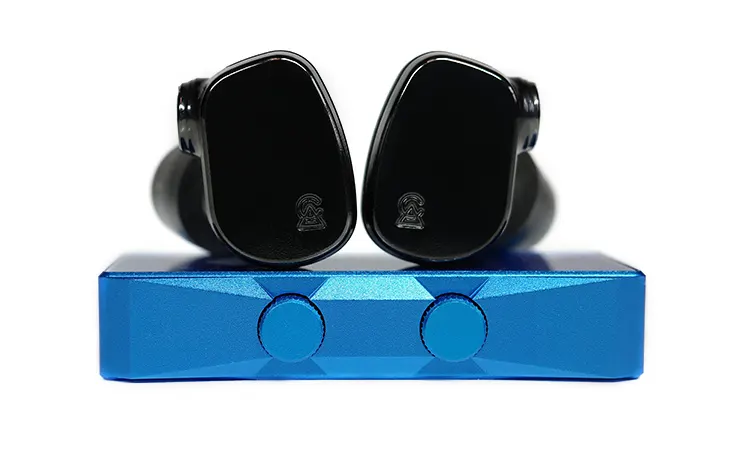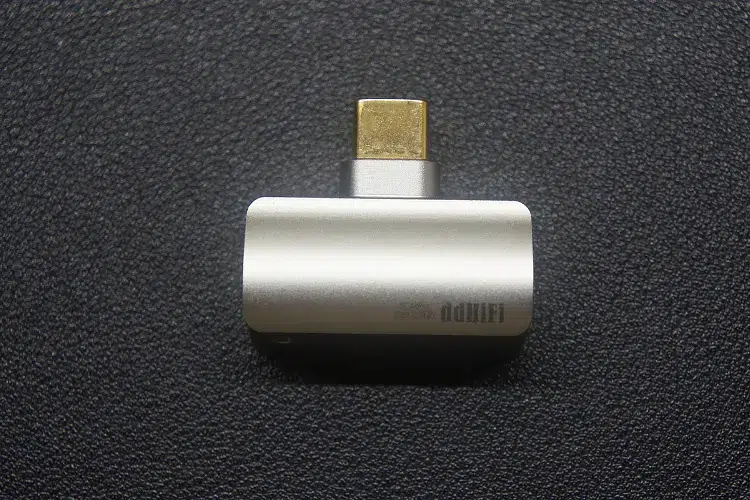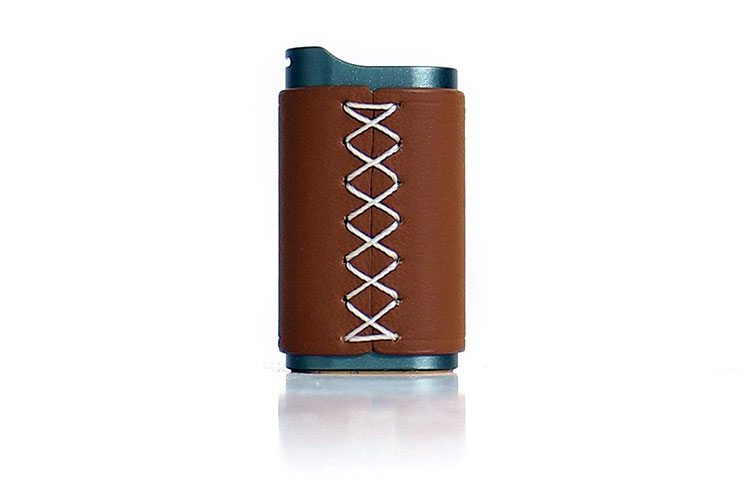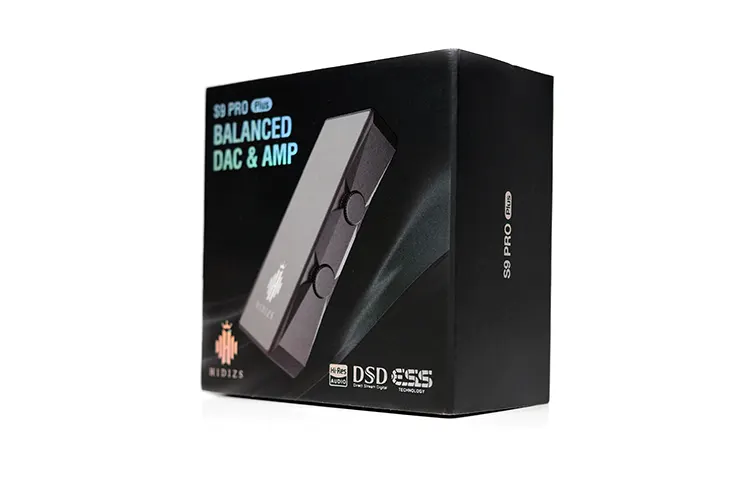Synergy
Having the six filter choices not only helps with different headphones and IEMs but also allows the user to tailor the signature for multiple genres and sources. This allows the S9 Pro Plus Martha to scale well across multiple sources and listening devices.
Efficiency
The S9 Pro Plus Martha did not have as quiet a background as I would have expected, especially with sensitive IEMs such as the Campfire Audio Solaris 2020. Between songs, the noise could be heard but dropped to inaudible when the music started.
The ES9038Q2M high-performance DAC chip is quite an acceptable chip for an affordable offering and can code PCM up to 32bit/768kHz and native DSD up to 512kHz.
Power
With 138mW+138mW@32Ω single-ended and 180mW+180mW@32Ω balanced, there is adequate power for most offerings. I did find the power was too much when paired with my Macbook Pro, (MBP), and had to run the system volume to near 0 to achieve listenable levels.
A firmware update (which must be done on a Windows-based computer) alleviates this by giving the user volume control on the S9 Pro Plus Martha itself. This is much appreciated. Those with an Apple product will need to update the firmware on another device.
That power translated into a vibrancy, which is the way most people look at the music on their Smartphones. Excited energy lends itself to much of what many listen to, and S9 Pro Plus Martha accommodated this extra energy, adding good vocals to the mix.
Pairings
Going through the filters allowed me to use the S9 Pro Plus Martha across some harder-to-drive listening sources such as the Spirit Torino IEM Twin Pulse Beryllium and the FiiO FT3 32 Ohm edition.
While not what I would consider hard-to-drive units, neither would normally be used with a Smartphone. Both functioned well, without issue and with plenty of power.
My favorite pairing with the iPhone was the Campfire Audio Solaris 2020, though. Known to have a more mature, smooth signature; the Solaris presented a more vibrant signature when changing filter options to red or white, enhancing the level of details as well.
Changing to the FT3 32 Ohm edition, the preferred filter was blue, which enhanced the lower frequencies, adding a bit of reverb. This to me warmed the FT3 just enough to not lose details, while giving a smoother signature.
When using my Macbook Pro, initially I had to limit the volume to 1-2 notches up on Tidal, since the firmware had not been updated. After finding a source where I could update the firmware, control of the volume became much more akin to a normal device. Still, I used the Audeze LCD-3 for the majority of my listening.
Adding a headphone such as the Audeze to your laptop is not normally a proposition many would do, but the S9 Pro Plus Martha provided enough power to adequately present itself with the LCD-3.
Understanding the limitations of the S9 Pro Plus Martha (and the MBP) allowed me to enjoy the pairing for what it was: engaging with enough vibrancy in tonality to counter the semi-typical “veiled” sound of the LCD-3.
The green and red filter choices worked especially well here, giving the Audeze the authority it normally imposes on the source music.
Select Comparisons
ddHiFi TC44Pro
Technical
Meldrick called the TC44Pro “a good portable dongle DAC with a balanced performance even for harder-to-drive IEMs,” but it “lacks a bit of power.”
The ddHiFi TC44Pro is a balanced-only portable DAC/AMP making use of dual Cirrus Logic CS43131 DAC chips that can natively decode up to PCM 32bit/384kHz and DSD256 formats.
Its balanced output is capable of up to 120mw into a 32Ω load, making it slightly less powerful than the S9 Pro Plus Martha in single-ended mode and much less in balanced mode.
Design
ddHiFi products have always come with top quality build, and the TC44Pro is no different. Diminutive in size, the small footprint comes about due to the circuitry being on a single PCB board.
Purchased as either a USB-C connection or lightning makes for an easy connection, without worry of losing adapters. The 30x18x12.5mm size also makes it pocketable, especially when the small lanyard is attached.
The titanium color presents a luxurious look, and at 9g is a minimal addition to your system. The left of the unit contains the indicator LED and the lanyard hole. The indicator LED is dimly lit, but just bright enough to show when power and signal are supplied to the dongle.
The right contains the single 4.4mm balanced jack. One potential issue for users is the size of the connection, which may or may not fit through the case of choice on your phone.
Performance
The TC44Pro did not add much coloring to the sound but added detail and resolution to the upper end of the frequency response.
The unit has a low SNR, which makes it quite good for sensitive IEMs that require a little bit more power to maximize dynamics. In that regard, the TC44Pro works as advertised.
This is another case where you could use your higher-class IEMs or headphones without bother and with a decent power upgrade on your Smartphone. The more neutral signature also allows you to utilize the EQ of your choice on your phone, without bother.
I would add that there is a bit better texture to the ddHiFi than the S9 Pro Plus Martha, but the filter choices certainly can accommodate the difference. I did wish for a bit more warmth, but understood the limitations of such a svelte device.
This is a very good basic option if you can work around the lack of volume controls and other features.
ddHiFi TC44C
When we reviewed the TC44C, it was quite a novelty, showing that a balanced dongle/DAC need not look boring while presenting competent sound qualities.
Louis summarized his review with, (the TC44C) “excels in the fact that it packages itself in a small shell and has a high-power output level that seems to be underrated.
But the tradeoff is the lack of features since there is no volume control or a mobile device app with sound shaping features or firmware upgrades.
Technical
The Cirrus Logic CS43131 is a 2-channel low-power DAC one-chip solution with a built-in amplifier (120mW at 32Ω). The chip can support headphone fingerprinting and amplification post-processing as well.
It uses little power to operate and the chip itself needs just a 2-volt DC power source to operate, with much better battery usage than the S9 Pro Plus Martha.
Design
The ddHiFi TC44C is somewhat small in size and measures 40.8x22x12.5mm while weighing 12.9 grams. The oblong shape is unique in the dongle/DAC world, and to me is one of the best looking as well.
The added leather sleeve not only gives the TC44C an upscale look but also functions to help the user grasp the device as well.
While it is heavier, I never felt it was too awkward in size or weight to be much of a bother. The longer included cable also meant it could sit more comfortably in my pocket, doubling back behind my iPhone.
The only fault which may hinder some is the raised lip where the lanyard attaches. It can get in the way of larger 3.5mm jacks rendering some of your IEMs useless in single-ended mode.
This does knock out most headphones in single-ended mode, but since I ran mostly balanced setups, found it acceptable.
Performance
The TC44C comes across to me as warmer in signature than the S9 Pro Plus Martha, but this can be “evened out” when using the filter choices. I also found that the power was quite adequate across my listening sources.
The level of detail on the TC44C was higher than the S9 Pro Plus Martha, with a darker background as well. That level of detail came about with good weight of notes, but without becoming mushy in thickness.
To me, the ddHiFi has better detail resolution as a result, but the filters can again accommodate that slight difference.
Combined, I found the soundstage of the TC44C to be larger in all dimensions than the S9 Pro Plus Martha, but not by much.
iKKO Zerda ITM02
In Michael’s summary, he states, “The iKKO Zerda ITM02 is budget-friendly, nicely designed, and with a good performance overall.
This is on par with 4x the price of DACs from a few years back. That is what we all want to see, right?” Affordable and with iKKO’s reputation for innovative, sound devices the ITM02 fits right into this comparison.
Technical
That affordability comes about by using technology, which is not the latest such as the AK4377 chip. Budget level, but still on the audiophile radar, the AK chip does its job without issue.
The Zerda ITM02 puts out only 70mW @32Ω, which is not enough to utilize on most audiophile headphones beyond 32Ω these days. In that vein, it is quite limited.
Both the ITM02 and S9 Pro Plus Martha use a fair bit of your phone’s power, draining my iPhone by about 20% (or more) after two hours of listening.
Design
Slightly smaller than the S9 Pro Plus Martha, the iKKO will fit well in your pocket and comes with both an iOS and Android (USB-C) cable.
The shape is still a familiar rectangle, but white. Build quality is as expected at this price point, and not out of character. It is well-built.
With only a 3.5mm single-ended connection you are limited to your “everyday” listening devices, but to be honest, most people in the market for something such as this only have 3.5mm jacked IEMs or headphones.
Performance
Presenting a brighter character than the S9 Pro Plus Martha, the iKKO will cater to those who prefer EDM or music, which comes across with a more vibrant signature. The background is not as black, either. But we are talking about a very basic dongle/DAC.
That brighter signature does not play too well with warmer amplifiers or headphones. Michael notes that when you drop the treble using an EQ, this can help, but the ITM02 is “so close” to becoming a very good generalist dongle/DAC regardless.
Without that change, those headphones or IEMs with a warmer signature were found to be lacking or altered from their normal signature, making for a disconnect that was not pleasing.
For a very basic dongle/DAC though, the iKKO is what many will be looking for: basic involvement, that adds some power.
Our Verdict
This is a tale of two verdicts, in reality. The first was a pre-firmware update, which came across as harsh and too powerful for my laptop. Not having the ability to change volume levels readily made for a device that was sorely lacking in ability. Even with the changing filter choices. But post firmware update, the S9 Pro Martha really shined.
I found myself changing filters mid-song to see what characteristics changed in my listening like a DJ might fine-tune his or her work. Other times I chose a specific filter based upon the musical genre I played.
Having the ability to change filters at the touch of two buttons is very beneficial. And once the volume update came, the S9 Pro Plus Martha performed flawlessly.
For a basic, valued-oriented dongle DAC Hidizs may have just set the bar a bit higher for other manufacturers. This is an easy recommendation for your Smartphone or laptop.
Hidizs S9 Pro Martha Technical Specifications
- ES9038Q2M High-Performance DAC Chip
- PCM Supports Up to 32bit/768kHz
- Native DSD Supports Up to 512
- Physical Buttons for Volume Control & 7 Filter Options
- 4mm Balanced & 3.5mm Single-ended Output
- 138mW+138mW@32Ω 3.5mm SE / 180mW+180mW@32Ω 4.4mm BAL
- Sampling Rate Indication RGB Lighting
- Compatible with all platforms: Windows/Mac OS/iPad OS/Android/iOS/Harmony OS
- Hi-Res Audio Certification






